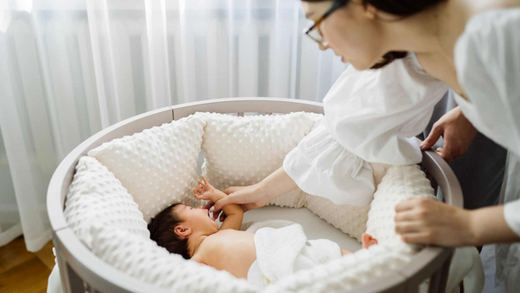
Navigating Sleep Training: Tips for Helping Your Baby (and You!) Get More Zzz's
Share
As a new parent, ensuring your baby gets quality sleep is essential for both their development and your well-being. Sleep training is a crucial part of teaching your baby to fall asleep independently and sleep through the night. This process not only helps your baby sleep better but also gives you the opportunity to get more sleep and rest. In this post, we’ll explore sleep training tips and methods, helping both you and your little one enjoy more peaceful nights.
What is Sleep Training?
Sleep training refers to the process of helping your baby learn to fall asleep and sleep through the night on their own. Babies naturally develop the ability to self-soothe as they grow, but some might need a little guidance in learning this skill. Starting sleep training at the right age, around 4 to 6 months, can be beneficial for both you and your baby. At this stage, your baby is ready to learn how to sleep independently and improve their overall sleep quality.
Popular Sleep Training Methods
There are several sleep training methods that you can choose from based on your preferences and your baby’s temperament:
-
Gentle Sleep Training: Many parents prefer gentle sleep training methods that focus on helping your baby fall asleep naturally. These include techniques like the Pick-Up/Put-Down method, where you soothe your baby when they cry and put them back into the crib once they’re calm. Another gentle approach is the Chair Method, where you gradually reduce your presence in the room over time. Both methods can reduce sleep disruptions without causing stress for the baby (Parents).
-
Ferber Method (Graduated Extinction): The Ferber Method is a more structured approach that involves allowing your baby to cry for progressively longer intervals before offering comfort. This method helps babies learn to self-soothe and fall asleep on their own, encouraging a deeper and more restful sleep for both parents and baby. Although this method can be tough, it’s an effective way to help your baby adjust to a more independent sleep routine (Happiest Baby).
-
Cry It Out (Extinction): This method involves allowing your baby to cry until they fall asleep, without intervention. While it can be tough for parents, it is a direct approach that can work well for some families. By allowing the baby to learn how to self-soothe without external assistance, it may lead to longer sleep periods and less frequent night waking (Happiest Baby).
Tips for Successful Sleep Training
-
Create a Consistent Bedtime Routine: A regular, calming pre-bedtime routine signals to your baby that it’s time to wind down and get ready for sleep. This might include activities such as a warm bath, reading a bedtime story, or cuddling in a quiet room. A consistent bedtime routine can promote better sleep habits and a smoother transition to sleep each night (NHS).
-
Design the Right Sleep Environment: Make sure your baby’s sleep area is quiet, dark, and comfortable. Using a white noise machine or a soft night light can create a relaxing environment that makes it easier for your baby to drift off to sleep. Ensuring that the baby’s sleep space is calm and conducive to rest will improve their sleep quality and help them sleep longer during the night (The Times).
-
Be Patient and Consistent: Sleep training is not an overnight process. It requires time, consistency, and patience. Stick to your chosen sleep training method, and be patient with both your baby and yourself as you adjust to the new routine. Trust that your baby will learn how to sleep independently with consistency over time, and their ability to self-soothe will improve (Happiest Baby).
-
Watch for Sleep Cues: Pay attention to your baby’s signs of sleepiness, such as rubbing their eyes or becoming fussy. Starting the bedtime routine when your baby is drowsy but still awake can help them fall asleep faster and more independently. Recognizing these cues can help ensure your baby goes to bed at the right time, which is key to building a healthy sleep schedule (Happiest Baby).
-
Consult with a Pediatrician or Sleep Consultant if Needed: If sleep training is not going as planned, or your baby is consistently waking up during the night, it might be helpful to consult with a pediatrician or a certified sleep consultant. A professional can provide personalized advice on sleep strategies and help address any sleep issues your baby may be facing.
When to Seek Professional Help
If sleep training methods do not seem to be working after a couple of weeks, or if your baby is showing signs of excessive distress, it may be time to consult with a pediatrician. They can help rule out any underlying medical issues that might be affecting sleep and offer additional strategies to help improve sleep patterns. In some cases, a pediatric sleep consultant may offer specialized guidance to help your baby adjust to a healthier sleep routine (What to Expect).
By incorporating these sleep training tips and sticking to a consistent routine, you can help your baby develop healthy sleep habits that will benefit both their development and your rest. Whether you choose a gentle approach or a more direct method, the goal is to ensure your baby learns to self-soothe and sleep independently. Sweet dreams for both you and your baby!
References:
